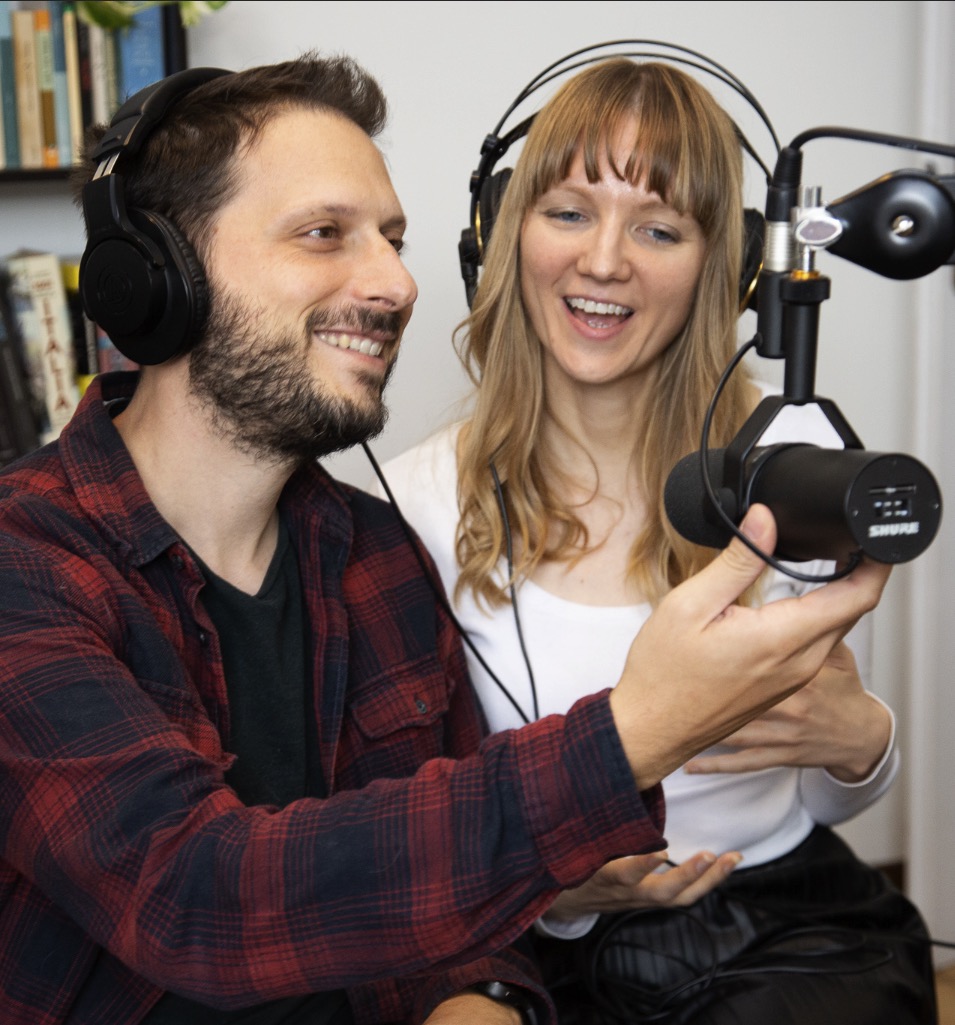Recently, we've been learning phrases like "mi manchi" (I miss you) and "mi dispiace" (I'm sorry). But what is the little "mi" at the beginning of these phrases? Learn about Italian pronouns and how to use them in Italian in episode 51 of 5 Minute Italian.
To help you remember what you learnt in today's lesson, below you'll find bonus materials including word lists, quizzes and flashcards. But first...
Become a 5-minute Italian member (it's free!)
Learn to speak and understand Italian faster by joining the 5 minute Italian club! When you sign up, you'll get:
- Mini Italian lessons + bonus materials delivered to your inbox.
- Access to the private Facebook group where you can practice chatting in Italian.
- Invites to free speaking workshops.
If you'd like to join us, click here to become a member of 5 Minute Italian.
Bonus Materials
Remember what you learnt with the bonus materials for today's episode.
Today's Italian words
Io sono inglese e tu sei italiano = I'm English and you're Italian.
Io = I
Sono = am
Inglese = English
E = and
Tu = you
Sei = are
Italiano = Italian
Mangio = I eat
Mangi = you eat
Mangiamo = we eat
Beh...io bevo il caffè e tu bevi il tè = Well I drink coffee and you drink tea.
Beh = well
io = I
bevo = I drink
il caffè = (the) coffee
e = and
tu = you
bevi = you drink
il tè = (the) tea
Tu cucini bene la pasta e io cucino bene i dolci = You cook pasta well and I cook desserts well
Tu = you
Cucini = you cook
Bene = well
La pasta = (the) pasta
e = and
io = I
cucino = I cook
bene = well
i dolci = (the) desserts
Ma non ci conformiamo sempre agli stereotipi = But we don't always conform to stereotypes.
Ma = but
Non = not
Ci conformiamo = we conform
Sempre = always
Agli = to the
Stereotipi = stereotypes
Io arrivo sempre in anticipo, tu sei sempre in ritardo! = I always arrive early and you're always late.
Io = I
Arrivo = I arrive
Sempre = Always
In anticipo = early (as in arrive early)
Tu = you
Sei = you are
Sempre = always
In ritardo = late
io = I
tu = you
lui = he
lei = she
noi = we
voi = you plural (you all/you both/y'all/yous depending on where you're from!)
loro = they
Lui beve il caffè e lei beve il tè = He drinks coffee and she drinks tea
Noi mangiamo la pasta e loro mangiano la pizza = We eat pasta and they eat pizza
Take the Quiz!
How much did you learn? Find out in the 5-minute Italian quiz!
Click here to take the quiz for this episode: Italian pronouns: What they are and how to use them
Italian flashcards
Remember the vocabulary from your 5 Minute Italian lessons by downloading the digital flashcard pack.
- Download the flashcards: [5MI 51] Italian pronouns
- Not sure how it works? Click here to watch the tutorial.
Transcript
Please note, this is not a word for word transcript.
Katie: Ciao a tutti e benvenuti a 5 Minute Italian, I’m Katie.
Matteo: And I’m Matteo.
K: Recently, we've been learning phrases like "mi manchi" (I miss you) and "mi dispiace" (I'm sorry). The little "mi" at the beginning of these phrases is an example of an Italian pronoun. Today and in the next couple of lessons, you'll learn what Italian pronouns are and how to use them in conversation.
M: First, ascoltiamo la conversazione (let's listen to the conversation).
K: Matteo, io sono inglese e tu sei italiano.
M: Si.
K: Noti alcune differenze?
M: Beh...io bevo il caffè e tu bevi il tè.
K: Tu cucini bene la pasta e io cucino bene i dolci.
M: Ma non ci conformiamo sempre agli stereotipi.
K: No?
M: Io arrivo sempre in anticipo, tu sei sempre in ritardo!
K: So you heard me say:
M: Matteo, io sono inglese. E tu sei italiano.
K: Matteo, I'm English and you're Italian. Word-for-word, that's:
M:
Io = I
Sono = am
Inglese = English
E = and
Tu = you
Sei = are
Italiano = Italian
K: The important words in this phrase for us today are: "io" (I) and "tu" (you), which are examples of Italian pronouns. What are pronouns?
Pronouns are just a fancy name for those little grammatical words which refer to people or things, like "I", "me" "you" and so on.
In today's lesson, we're looking specifically at subject pronouns, which are words like I, you, he, she, we, and they. In English, they come before the verb and tell us who's doing the action.
"I eat"
"You eat"
"We eat"
And so on.
The important thing to know about subject pronouns in Italian is that we don't use them as often in English.
M: Yes, we don't need to, because in Italian, the verb already tells us who's doing the action. For example:
Mangio = I eat
Mangi = you eat
Mangiamo = we eat
K: The only time we use subject pronouns in Italian is when we want to add emphasis to the person, like in today's conversation. If I wanted to do this in English, I'd use intonation: "I'M English and YOU'RE Italian". But in Italian, we can't do this, so we add the pronouns instead, "IO sono inglese" and "TU sei italiano". We can also see this in the next sentence. I asked "noti alcune differenze?" Do you notice any differences? And Matteo said:
M: Beh...io bevo il caffè e tu bevi il tè.
K: Well I drink coffee and YOU drink tea.
M:
Beh = well
io = I
bevo = I drink
il caffè = the coffee
e = and
tu = you
bevi = you drink
il tè = the tea
K: Then I said:
M: Tu cucini bene la pasta e io cucino bene i dolci.
K: YOU cook pasta well and I cook desserts well.
M:
Tu = you
Cucini = you cook
Bene = well
La pasta = the pasta
e = and
io = I
cucino = I cook
bene = well
i dolci = the desserts
K: Then Matteo said:
M: Ma non ci conformiamo sempre agli stereotipi.
K: But we don't always conform to stereotypes.
M:
Ma = but
Non = not
Ci conformiamo = we conform
Sempre = always
Agli = to the
Stereotipi = stereotypes
Then I said "no?" as a question. And Matteo's explanation was:
M: Io arrivo sempre in anticipo, tu sei sempre in ritardo!
K: I always arrive early and you're always late. This is true I'm afraid - Matteo spends half his time waiting, trying to get me out the house, so we don't conform to stereotypes in this respect!
M:
Io = I
Arrivo = I arrive
Sempre = Always
In anticipo = early (as in arrive early)
Tu = you
Sei = you are
Sempre = always
In ritardo = late
K: So we've seen io and tu, which mean I and you respectively. What about the others?
M: We've got:
io = I
tu = you
lui = he
lei = she
noi = we
voi = you plural (you all/you both/y'all/yous depending on where you're from!)
loro = they
K: So if "he" or "she" drinks is "beve" how would you say "he drinks coffee and she drinks tea" (remember that in Italian we say "the coffee" and "the tea")
M: Lui beve il caffè e lei beve il tè.
K: Great. And how would you say "we eat pasta and they eat pizza" (remember it's "the pasta" and "the pizza"). Just in case you need a little reminder on how to conjugate Italian verbs, we eat is mangiamo. They eat is mangiano.
M: Noi mangiamo la pasta e loro mangiano la pizza.
K: So today we learnt about subject pronouns, next week we'll learn about object pronouns in Italian. To help you remember what you learnt today, you'll find bonus materials including a quiz and vocabulary flashcards on our website - head over to www.joyoflanguages.com/italianpodcast and scroll down to this episode. Or follow the link in the show notes to go straight there. You can also practice your Italian with us by joining our Facebook group, you'll find the link in the show notes below. Ciao for now, or as we say in Italian:
M: Alla prossima!
Get more 5-minute Italian
To get more 5 minute Italian, including lessons delivered to your inbox, access to the private Facebook group and invites to speaking workshops, click here to become a 5 Minute Italian member.

